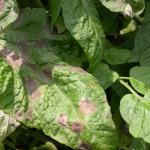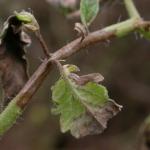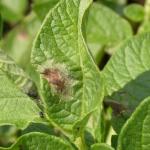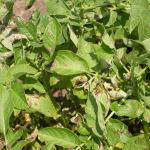Late Blight on Tomatoes and Potatoes
Home gardeners should be aware of Late Blight caused by Phytophthora infestans – a very destructive and very infectious disease that kills tomato and potato plants in gardens and on commercial farms across the U.S. Because the disease can move very easily from one garden or field to others, it is critical that both home gardeners and farmers know how the disease works, what to look for, and how to manage it. Given the right conditions, the spores are easily carried for miles in wind currents to infect susceptible plants in even the most remote parts in our region. All tomato and potato plants grown in home gardens and in commercial fields are susceptible to late blight!
Late blight is the same disease that caused the Irish Potato Famine in the 1840s. It has been in the US for over a century, but it has become more of a concern in the Northeast in recent years. In 2009 a widespread outbreak affected both home gardens and commercial farms on a broad scale, causing significant yield losses in both tomato and potato. Since then, it has continued to appear throughout New England in farm fields and home gardens, but fortunately it has not caused losses at the same level. Keeping the disease in check requires attention and vigilance from gardeners and farmers alike.
Symptoms
The most common early symptoms on tomato transplants are brown lesions on stems, with white fungal growth developing under moist conditions.
Symptoms on plants in the garden appear as large (at least nickel-sized) olive-green to brown spots on leaves with slightly fuzzy white fungal growth on the underside when conditions have been humid or wet. Sometimes the lesion border is yellow or has a water-soaked appearance. Leaf lesions begin as tiny, irregularly shaped brown spots. Brown to blackish lesions also develop on upper stems. Firm, brown spots develop on tomato fruit. Late blight can sometimes be confused with early blight and Septoria leaf spot, two common diseases found in home gardens. If the lesion has a yellow border and is occurring on the bottom of the plant, it is likely due to infection of either early blight or Septoria leaf spot.
Photo gallery of what to look for: http://ag.umass.edu/home-lawn-garden/fact-sheets/late-blight-on-tomatoes...
Life Cycle
P. infestans in the Northeast survives in infected potato tubers that were saved from last year for seed or that were disposed of in compost piles or cull piles, or left in the garden in soil that did not freeze during the winter. The pathogen does not overwinter in tomato plants or debris, and is not seed-borne. In more southern and tropical regions, the pathogen produces long-lived sexual spores (Oospores) that survive in infected crop debris and the soil. Fortunately, there is currently no evidence that this happens in New England.
Wherever infected tubers or plants are found, if conditions are favorable, the plants will develop late blight lesions that release sporangia. Sporangia are spread long distances by wind and wind-driven rain. In cloudy, gray weather, the clouds protect spores being dispersed in wind from the killing effect of ultraviolet radiation. Spores land on leaf tissue and penetrate the leaf, causing rapid decline and death of the plant under favorable conditions, Phytophthora infestans is favored by cool (below 77 F), wet weather. Hot, dry periods are not conducive to late blight development. An exception would be where plantings are overhead watered or are located where fog occurs regularly such as near rivers or in coastal areas.
The late blight pathogen has recently undergone changes in Florida that affect disease occurrence there and in other eastern states. Diseased tomato plants in south Florida have survived cold periods in winter allowing the pathogen to persist. Late blight has also been active into the spring as late as May indicating an increased tolerance for warmer temperatures. This means a potential source of inoculum persists into the spring, when crops are being produced north of Florida and thus a ‘green bridge’ exists for the pathogen to progress on until it reaches the northeast.
Prevention and Management
- Do not plant potato tubers from the previous year; purchase seed potatoes from a reputable source and inspect them before planting.
- Destroy volunteer potatoes that sprout from overwintered tubers. The late blight organism requires living tissue to survive; it does not survive in the soil or carried tomato seed. The most likely source of late blight is infected potato tubers that survived the winter, tubers that were saved, or tubers that remained in the soil unfrozen and grow from overwintered tubers as volunteer potato plants. These plants should be dug up, placed in a plastic bag and discarded in the trash or completely buried deep enough so plants decompose and will not resprout.
- Select resistant varieties were available. ‘Mountain Magic’, ‘Legend’, and ‘Plum Regal’ have excellent resistance to Late Blight. ‘Red Pearl’ and ‘Matt’s Wild Cherry’ are small fruited tomatoes with good resistance. Some heirloom tomato varieties have good tolerance to late blight. A few cultivars also have resistance to Early Blight (Alternaria solani, A. tomatophila) and should be considered. The development of triple (LB, EB, Septoria leaf spot) resistant varieties is underway at Cornell and other Universities.
- Start with disease-free tomato transplants. Growing your own tomato transplants from seed or purchasing transplants that were started here in the Northeast from seed will ensure a healthy start to the season for you and local farms.
- Control solanaceous weeds such as hairy nightshade, jimson weed, golden henbane, and others.
- Plant potatoes and tomatoes where air circulation is good; stake tomatoes for more rapid dying of leaves after dew or rainfall.
If symptoms are already appearing on plants, remove plants, place in a plastic bag, seal and discard in the trash or completely bury plants deep enough underground so plants decompose and will not re-sprout. Do not put the plants in a compost pile as spores will still spread from this debris.
Fungicides
To manage late blight with fungicides, treat before symptoms appear. Use a product that contains chlorothalonil listed as the active ingredient on the label. There are ready- to- use formulations available to home gardeners. Fungicides are only effective if used before the disease appears and should be reapplied every 5-7 days if wet weather persists. Chlorothalonil is a protectant fungicide, with no systemic movement in the plant, so thorough coverage is necessary.
Copper based fungicides are another option for home gardeners, and are reasonably effective against some strains of the late blight fungus. For organic gardeners, copper based fungicides are the only allowed option. As with all pesticides, read the label carefully and follow instructions for personal protective clothing, rates, and interval between spraying and harvest. These fungicides will also reduce losses from early blight and Septoria leaf spot, which are widespread in gardens and on farms every year from July till frost. If late blight is widespread in the region and weather conditions are favorable for the disease, fungicides alone may not guarantee a healthy crop.
FAQ’s about Late Blight on Tomatoes
I think I had late blight on my tomatoes last year, will it overwinter in my garden?
Tomatoes will not carry late blight over the winter, because freezing kills the whole plant.
Will seed from any tomatoes left in the garden from last year carry over the disease?
Tomato seed, even from fruit that was infected with late blight, will not carry the pathogen, so no need to worry about the tomatoes left behind in the garden or compost pile.
What about my tomato stakes, will it carry over on my tomato stakes?
No, late blight will not survive on tomato stakes and cages. However, other diseases can survive on tomato stakes. Remove dirt and debris from tomato stakes and disinfect stakes by cleaning them with 1 part bleach + 9 parts water. Soak stakes for 30 minutes. Let dry before using them.
I grew potatoes last year. Can late blight over-winter on potatoes I may have left in the garden?
Potatoes that freeze or fully decompose will not carry the pathogen over winter. However, the biggest threat for overwintered disease in New England is on potatoes that might come up this year. In the spring, inspect last year’s potato plot and any compost or cull piles for volunteer potato plants. If you find potato plants, pull them out and put them in the trash or destroy them. If tubers were infected and survive, then the late blight pathogen could grow upward from the tuber, infecting the stem and producing spores when weather conditions are favorable. These spores could then disperse to other tomato and potato plants.
Is there anything else I can do to prevent late blight this year?
Yes, late blight is not seedborne (however, it is tuber-borne in potato), so tomato plants started from seed locally (in the Northeast) would be free of the disease. Growing your own tomato transplants from seed or purchasing transplants that were started here in the Northeast from seed will ensure a healthy start to the season for you and local farms. Disease-resistant or tolerant varieties of tomatoes exist, however seed is in limited supply this year, so you will not likely find them at your garden center. ‘Mountain Magic’, ‘Plum Regal’, and ‘Legend’ are three varieties with resistance or tolerance to late blight. Note that the variety ‘Legend’ is the only late-blight resistant variety for which seed is readily available this year.
Also, purchase certified, disease-free seed potato from a reputable source Examine your seed potatoes and plant only firm, blemish-free tubers.
I have spots on my tomato plants that show up in June or July every year. Could this be late blight?
Probably not. In addition to late blight, each year tomatoes become infected with early blight and Septoria leaf spot, which look very similar to late blight symptoms. If you have problems with early blight each year, consider growing tomato plant varieties that are resistant or tolerant to early blight, such as the varieties ‘Mountain Fresh’, ‘Mountain Supreme’, and ‘Plum Dandy’ and others.
For more information, see the UMass Vegetable site.



